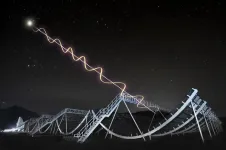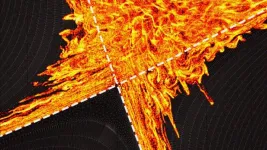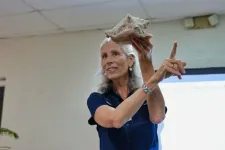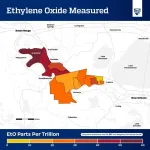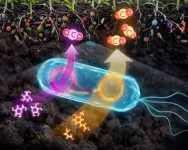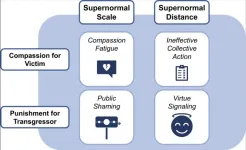(Press-News.org) TORONTO, ON, June 11, 2024 — What scientists previously thought about where Fast Radio Bursts (FRBs) come from is just the tip of the iceberg, according to new research led by astronomers at the University of Toronto. The mysteries of the millisecond-long cosmic explosions are unfolding with a new way of analyzing data from the Canadian Hydrogen Intensity Mapping Experiment (CHIME).
Published today in The Astrophysical Journal, the study details the properties of polarized light from 128 non-repeating FRBs — those from sources that have only produced a single burst to date. It finds that they appear to come from galaxies like our own Milky Way with modest densities and modest magnetic fields.
Previous studies of FRBs have focused on much smaller samples of hyperactive repeating sources that, in contrast, appear to originate in dense, extremely magnetized environments. Only about 3 per cent of known FRBs repeat, coming from a source that has produced multiple bursts since being found.
Most radio telescopes can only see small points in the sky, making it easier to focus on repeating FRBs with known positions. CHIME can survey an extremely large area of the sky to detect both repeating and non-repeating FRBs.
“This was the first look at the other 97 per cent,” says lead author Ayush Pandhi, a PhD student at the Dunlap Institute for Astronomy & Astrophysics and the David A. Dunlap Department of Astronomy & Astrophysics at the University of Toronto. “It allows us to reconsider what we think FRBs are and see how repeating and non-repeating FRBs may be different.”
First detected in 2007, FRBs are extremely energetic flashes from distant sources across the universe. While over 1,000 FRBs have been catalogued since then, scientists do not yet know exactly where or how they are produced. They have also questioned whether repeating and non-repeating FRBs originate in similar environments.
“This is a new way to analyze the data we have on FRBs. Instead of just looking at how bright something is, we’re also looking at the angle of the light’s vibrating electromagnetic waves,” says Pandhi. “It gives you additional information about how and where that light is produced, and what it has passed through on its journey to us over many millions of light years.”
All light travels as waves that we interpret as different colours depending on the lengths between its peaks and valleys. Much of the light in the universe travels in wavelengths that the human eye cannot see, including light from FRBs, but radio telescopes like CHIME can.
Polarized light is made up of waves that vibrate in a single plane—vertically, horizontally, or another angle in between. The direction that light from FRBs is polarized was seen to change in two ways: with time and with the colour of the light. These changes can explain how an FRB might have been produced and what kind of material it passes through on its journey to Earth.
Studying how the direction of polarization changes for different colours of the light can tell us about the local density of where an FRB is produced and the strength of the magnetism that is present within it.
To determine what FRBs are and how they are produced, scientists need to understand their local environments. This study concludes that most FRBs, those that do not repeat, are not like the few repeating sources that have been previously studied. It suggests that this sample is either a separate population or more evolved versions of the same population that originate in a less extreme environment with a lower burst rate.
Collaborating institutions include the Dunlap Institute at the University of Toronto, the University of California Santa Cruz, University of Amsterdam and McGill University.
The CHIME project is co-led by the University of British Columbia, McGill University, University of Toronto and the Dominion Radio Astrophysical Observatory with collaborating institutions across North America. It is located at the Dominion Radio Astrophysical Observatory, a national facility for astronomy operated by the National Research Council of Canada, on the traditional, ancestral and unceded territory of the Syilx/Okanagan people.
About the Dunlap Institute for Astronomy & Astrophysics
The Dunlap Institute for Astronomy & Astrophysics in the Faculty of Arts & Science at the University of Toronto is an endowed research institute with over 80 faculty, postdocs, students and staff, dedicated to innovative technology, groundbreaking research, world-class training and public engagement.
The research themes of its faculty and Dunlap Fellows span the Universe and include: optical, infrared and radio instrumentation, Dark Energy, large-scale structure, the Cosmic Microwave Background, the interstellar medium, galaxy evolution, cosmic magnetism and time-domain science.
The Dunlap Institute, the David A. Dunlap Department of Astronomy & Astrophysics and other researchers across the University of Toronto’s three campuses together comprise the leading concentration of astronomers in Canada, at the leading research university in the country.
###
END
Origins of fast radio bursts come into focus through polarized light
Study detailing the properties of polarized light from 128 non-repeating FRBs reveals mysterious cosmic explosions originate in far-away galaxies like our own Milky Way
2024-06-11
ELSE PRESS RELEASES FROM THIS DATE:
Press registration opens for ACS Fall 2024
2024-06-11
WASHINGTON, June 11, 2024 — Journalists who register for the fall meeting of the American Chemical Society (ACS) will have access to about 10,000 presentations on topics including agriculture and food, energy and fuels, health and medicine, sustainability, and more. ACS Fall 2024 is a hybrid meeting being held virtually and in person in Denver on Aug. 18-22, with the theme “Elevating Chemistry.”
ACS considers requests for press credentials and complimentary meeting registration from reporters (staff and freelance) and public information officers at government, nonprofit and educational institutions. Please ...
New plasma escape mechanism could protect fusion vessels from excessive heat
2024-06-11
The furious exhaust heat generated by a fusing plasma in a commercial-scale reactor may not be as damaging to the vessel’s innards as once thought, according to researchers at the U.S. Department of Energy’s (DOE) Princeton Plasma Physics Laboratory (PPPL), Oak Ridge National Laboratory and the ITER Organization (ITER).
“This discovery fundamentally changes how we think about the way heat and particles travel between two critically important regions at the edge of a plasma during fusion,” said PPPL Managing Principal Research Physicist Choongseok Chang, who led ...
Endocrine Society urges passage of the Right to IVF Act
2024-06-11
WASHINGTON—The Endocrine Society endorses the Right to IVF Act, which was introduced by Senators Cory Booker (D-NJ), Patty Murray (D-WA) and Tammy Duckworth (D-IL) to protect and expand nationwide access to fertility treatment, including in vitro fertilization (IVF), and urges the Senate to pass the Right to IVF Act on June 12th to ensure that the freedom to start and grow a family is protected and accessible to everyone in the United States.
Infertility affects an increasing number of individuals. ...
FAU Harbor Branch launches ‘eConch’ to grow and conserve the queen conch
2024-06-11
The queen conch (Aliger gigas) is a prized delicacy long harvested for food and revered for its beautiful shell. With a lifespan between 25 to 40 years, the queen conch is second only to the spiny lobster fishery and is the most important molluscan fishery in the Caribbean region.
Deeply rooted in the way of life in the Caribbean, many island communities depend on queen conch for their livelihoods. However, intensive fishing and habitat degradation from urbanization and climate change have caused conch populations ...
Surprisingly high levels of toxic gas found in Louisiana
2024-06-11
The toxic gas ethylene oxide, at levels thousand times higher than what is considered safe, was detected across parts of Louisiana with a cutting-edge mobile air-testing lab. The concentrations found dwarfed Environmental Protection Agency estimates for the region.
The findings, led by Johns Hopkins University environmental engineers, suggest significantly higher cancer risks for people who live near facilities that manufacture and use ethylene oxide, as well as a need for more accurate and reliable tools to monitor emissions.
“I don’t think there’s any census track in the area that wasn’t at higher risk for cancer than we would deem acceptable,” said ...
Soil bacteria respire more CO2 after sugar-free meals
2024-06-11
When soil microbes eat plant matter, the digested food follows one of two pathways. Either the microbe uses the food to build its own body, or it respires its meal as carbon dioxide (CO2) into the atmosphere.
Now, a Northwestern University-led research team has, for the first time, tracked the pathways of a mixture of plant waste as it moves through bacteria’s metabolism to contribute to atmospheric CO2. The researchers discovered that microbes respire three times as much CO2 from lignin carbons (non-sugar aromatic units) compared to cellulose carbons (glucose sugar units), which both add structure and support ...
Human evolution and online morality
2024-06-11
In a Review article, Claire Robertson and colleagues explore how human morality, which evolved in the context of small in-person groups, functions on the internet with over five billion users. Evolved human responses, such as compassion for victims and urges to punish transgressors, operate differently online, the authors argue. The internet exposes users to large quantities of extreme morally relevant stimuli in the form of 24-hour news and intentionally outrageous content from sometimes physically distant locations. Subjecting human brains to this ...
Price sensitivity to unhealthy foods
2024-06-11
Consumer data shows people with obesity are more price-sensitive than others when it comes to buying unhealthy foods, suggesting a food tax could be an effective public health measure. Taxes on sugar-sweetened beverages have become a commonly employed policy to improve public health. Less common are taxes on unhealthy foods, such as candy, cookies, or potato chips--and there is little data on whether such taxes would improve public health. Ying Bao and colleagues examined whether individuals of various ...
Book bans as political action
2024-06-11
In the 2021–2022 school year, schools banned books more often than ever before in United States history. Katie Spoon, Isabelle Langrock, and colleagues analyzed data from PEN America on 2,532 book bans that occurred during the year, in combination with county-level administrative data, book sales data, and a novel crowd-sourced dataset of author demographic information. The research team found that people of color are several times more likely to be the authors of banned books than White authors and that a considerable proportion of banned books, both fictional and historical, feature characters of color. About 37% of banned books were children’s ...
New study shows metabolic and bariatric surgery prevents pre-diabetes from developing into type 2 diabetes in most patients
2024-06-11
Patients with pre-diabetes and severe obesity who had metabolic and bariatric surgery were 20-times less likely to develop full-blown type 2 diabetes over the course of 15 years than patients with the condition who did not have surgery, according to a new study* presented today at the American Society for Metabolic and Bariatric Surgery (ASMBS) 2024 Annual Scientific Meeting.
Only 1.8% of patients progressed to a diagnosis of diabetes in five years after metabolic surgery (Roux-en-Y gastric bypass or sleeve gastrectomy), which rose to 3.3% in 10 years and 6.7% after 15 years. The protective effect against diabetes was higher ...
LAST 30 PRESS RELEASES:
Researchers observe gas outflow driven by a jet from an active galactic nucleus
Pitt student finds familiar structure just 2 billion years after the Big Bang
Evidence of cross-regional marine plastic pollution in green sea turtles
Patients with clonal hematopoiesis have increased heart disease risk following cancer treatment
Stem cell therapy for stroke shows how cells find their way in the brain
Environment: Up to 4,700 tonnes of litter flows down the Rhine each year
Maternal vaccine receipt and infant hospital and emergency visits for influenza and pertussis
Interim safety of RSVpreF vaccination during pregnancy
Stem cell engineering breakthrough paves way for next-generation living drugs
California grants $7.4 million to advance gene-edited stem cell therapy for Friedreich’s ataxia
Victoria’s Secret grant backs cutting-edge ovarian cancer research
Research paves the way for safer colonoscopy bowel prep for people with compromised gut health
JMIR Publications and Sweden's National Library announce renewal and expansion of flat-fee unlimited open access partnership for 2026
A new 3D-printed solar cell that’s transparent and color-tunable
IV iron is the cost-effective treatment for women with iron deficiency anemia and heavy menstrual bleeding
Doing good pays off: Environmentally and socially responsible companies drive value and market efficiency
City of Hope and Cellares to automate manufacturing of solid tumor CAR T cell therapy
Short-circuiting pancreatic cancer
Groundbreaking mapping: how many ghost particles all the Milky Way’s stars send towards Earth
JBNU researchers propose hierarchical porous copper nanosheet-based triboelectric nanogenerators
A high-protein diet can defeat cholera infection
A more accurate way of calculating the value of a healthy year of life
What causes some people’s gut microbes to produce high alcohol levels?
Global study reveals widespread burning of plastic for heating and cooking
MIT study shows pills that communicate from the stomach could improve medication adherence
Searching for the centromere: diversity in pathways key for cell division
Behind nature’s blueprints
Researchers search for why some people’s gut microbes produce high alcohol levels
Researchers find promising new way to boost the immune response to cancer
Coffee as a staining agent substitute in electron microscopy
[Press-News.org] Origins of fast radio bursts come into focus through polarized lightStudy detailing the properties of polarized light from 128 non-repeating FRBs reveals mysterious cosmic explosions originate in far-away galaxies like our own Milky Way
